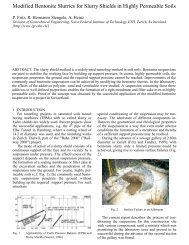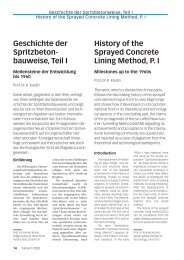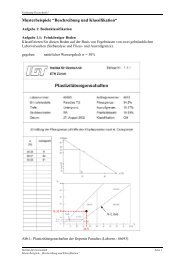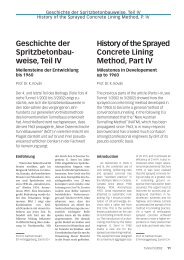Erroneous Concepts behind NATM
Erroneous Concepts behind NATM
Erroneous Concepts behind NATM
You also want an ePaper? Increase the reach of your titles
YUMPU automatically turns print PDFs into web optimized ePapers that Google loves.
This definition contains three principal statements:<br />
- the ground becomes a load bearing structural component,<br />
- to achieve this a particular concept is required,<br />
- the concept consists of the activation of a ground ring.<br />
In this and the following chapters emphasis will be given to the published material of<br />
the authors of the <strong>NATM</strong>, i.e. L. Rabcewicz, L. Müller and F. Pacher (often referred to<br />
as the "fathers" of the <strong>NATM</strong>). Reference will also be made to the work of the second<br />
generation of <strong>NATM</strong> exponents.<br />
1.1 The ground as load bearing component<br />
The essence of the above definition is that, under the <strong>NATM</strong>, the ground (i.e. rock or<br />
soil mass) itself becomes part of the load-bearing system. The definition emphasises<br />
that property of the <strong>NATM</strong> which distinguishes it from all related concepts, i.e. from<br />
other tunnelling methods. Presumably, under this method alone the ground becomes a<br />
structural component. From this basic statement other well-known formulations have<br />
been derived and frequently reported in <strong>NATM</strong> literature. For example, under the <strong>NATM</strong>:<br />
- the support capacity of the ground is brought into play,<br />
- the ground supports itself,<br />
- the main load bearing component is the surrounding ground,<br />
- the ground is transformed from a loading to a supporting medium,<br />
- the self-supporting capacity of the ground is exploited,<br />
- one works with and not against the ground, etc...<br />
The claim that the <strong>NATM</strong> alone allows the ground to act as a structurally supporting<br />
component is basically false. In reality, tunnelling without the structural action of the<br />
ground is inconceivable. Whether the engineer employs a technical measure to support<br />
the underground opening or not makes no difference to the inherent support action of<br />
the ground. By trusting instinctively the mechanical laws governing a rock mass, man<br />
has occupied caves since early times and has made underground openings of various<br />
types for his own purposes. One can show in fact that the idea of the ground as a<br />
structural element is inherent to the concept of a tunnel. This knowledge is logically independent<br />
of experience, since it follows directly from fundamental mechanical principles.<br />
Thus the <strong>NATM</strong> claims for itself what is a universal necessity (the structural support action<br />
of the ground) which is also effective for all other methods of tunnelling and<br />
characterizes tunnelling per se. In order to elucidate the logical error of the definition of<br />
the <strong>NATM</strong> let us consider the following simple example of a similar false definition:<br />
“The New Swimming Technique is based on the concept that by activation of uplift the<br />
water becomes a supporting medium”.<br />
2






